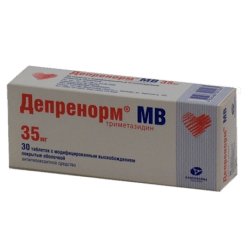No products in the cart.
Deprenorm MB 70 mg, 30 pcs.
€1.00
Out of stock
(E-mail when Stock is available)
Description
Pharmacodynamics
It has an antihypoxic effect. Trimetazidine prevents decrease in intracellular concentration of adenosine triphosphate (ATP) by maintaining energy metabolism of cells in hypoxia.
Thus, the drug ensures normal functioning of membrane ion channels, transmembrane transport of potassium and sodium ions and preservation of cellular homeostasis.
. Trimetazidine inhibits fatty acid oxidation through selective inhibition of the enzyme 3-ketoacyl-CoA-thiolase (3-CAT) mitochondrial long-chain fatty acid isoform, which leads to increased glucose oxidation and accelerated glucose-oxidized glycolysis, which is responsible for myocardial protection from ischemia. The switch of energy metabolism from fatty acid oxidation to glucose oxidation underlies the pharmacological properties of trimetazidine.
Trimetazidine has been experimentally confirmed to have the following properties:
- maintains energy metabolism of cardiac and neurosensory tissues during ischemia;
- reduces the severity of intracellular acidosis and changes in transmembrane ion flow that occur during ischemia;
- reduces the size of myocardial damage;
- does not directly affect hemodynamic parameters.
In patients with angina pectoris, trimetazidine:
- increases coronary reserve, thereby delaying the onset of exercise-induced ischemia from day 15 of therapy;
- limits exercise-induced blood pressure fluctuations without significant changes in heart rate;
- reduces the frequency of angina attacks and the need for short-acting nitroglycerin;
- improves left ventricular contractile function in patients with coronary dysfunction.
Pharmacokinetics
After oral administration, trimetazidine is absorbed from the gastrointestinal tract and reaches maximum plasma concentration after approximately 5 hours. Above 24 hours, plasma concentrations remain above the 75% concentration determined after 11 hours. The equilibrium state is reached after 60 hours. Food intake does not affect the bioavailability of trimetazidine.
The volume of distribution is 4.8 l/kg, which indicates good distribution of trimetazidine in tissues (the degree of binding to plasma proteins is quite low, about 16 % in vitro). Trimetazidine is mainly excreted by the kidneys, mainly unchanged. Renal clearance of trimetazidine directly correlates with creatinine clearance (CK), hepatic clearance decreases with patient age.
Indications
Indications
Coronary heart disease:
prevention of attacks of stable angina (as part of combination therapy).
Pharmacological effect
Pharmacological effect
Pharmacodynamics
Has an antihypoxic effect. Trimetazidine prevents a decrease in intracellular adenosine triphosphate (ATP) concentration by maintaining the energy metabolism of cells in a state of hypoxia.
Thus, the drug ensures the normal functioning of membrane ion channels, transmembrane transport of potassium and sodium ions and the preservation of cellular homeostasis.
Trimetazidine inhibits the oxidation of fatty acids due to the selective inhibition of the enzyme 3-ketoacyl-CoA thiolase (3-CAT) of the mitochondrial long-chain isoform of fatty acids, which leads to increased oxidation of glucose and acceleration of glycolysis with oxidation of glucose, which determines the protection of the myocardium from ischemia. The switch of energy metabolism from fatty acid oxidation to glucose oxidation underlies the pharmacological properties of trimetazidine.
It has been experimentally confirmed that trimetazidine has the following properties:
supports energy metabolism of the heart and neurosensory tissues during ischemia;
reduces the severity of intracellular acidosis and changes in transmembrane ion flow that occur during ischemia;
reduces the level of migration and infiltration of polynuclear neutrophils in ischemic and reperfused heart tissues;
reduces the size of myocardial damage;
does not have a direct effect on hemodynamic parameters.
In patients with angina, trimetazidine:
increases coronary reserve, thereby slowing down the onset of ischemia caused by physical activity, starting from the 15th day of therapy;
limits exercise-induced blood pressure fluctuations without significant changes in heart rate;
reduces the frequency of angina attacks and the need for short-acting nitroglycerin;
improves contractile function of the left ventricle in patients with ischemic dysfunction.
Pharmacokinetics
After oral administration, trimetazidine is absorbed from the gastrointestinal tract and reaches maximum plasma concentrations after approximately 5 hours. Over 24 hours, the concentration in the blood plasma remains at a level exceeding 75% of the concentration determined after 11 hours. The equilibrium state is reached after 60 hours. Food intake does not affect the bioavailability of trimetazidine.
The volume of distribution is 4.8 l/kg, which indicates good distribution of trimetazidine in tissues (the degree of binding to plasma proteins is quite low, about 16% in vitro). Trimetazidine is excreted mainly by the kidneys, mainly unchanged. Renal clearance of trimetazidine directly correlates with creatinine clearance (CC), hepatic clearance decreases with patient age.
Special instructions
Special instructions
Deprenorm® MB is not intended for the relief of angina attacks, for the initial course of treatment of unstable angina or myocardial infarction, as well as in preparation for hospitalization or in its first days.
If an attack of angina occurs, treatment (drug therapy or revascularization) should be reviewed and adapted.
The drug may cause or worsen symptoms of parkinsonism (tremor, akinesia, increased tone), so patients should be regularly monitored, especially the elderly. If movement disorders appear, such as symptoms of parkinsonism, restless legs syndrome, tremor, instability in the Romberg position and unsteadiness of gait, the drug Deprenorm® MB should be permanently discontinued.
Such cases are rare and symptoms usually resolve after discontinuation of therapy, in most patients within 4 months after discontinuation of the drug. If symptoms of parkinsonism persist more than 4 months after discontinuation of the drug, you should consult a neurologist. Falls associated with unsteadiness in the Romberg position and unsteady gait or arterial hypotension may occur, especially in patients taking antihypertensive drugs (see section “Side effects”).
Impact on the ability to drive vehicles and other mechanisms that require increased concentration
Due to the possible development of dizziness and other side effects when using the drug Deprenorm® MB, caution should be exercised when driving vehicles and engaging in other potentially hazardous activities that require increased concentration and speed of psychomotor reactions.
Active ingredient
Active ingredient
Trimetazidine
Composition
Composition
1 extended-release film-coated tablet contains:
Active ingredient:
trimetazidine dihydrochloride 70 mg.
Excipients:
hypromellose (hydroxypropyl methylcellulose) 171 mg;
carbomer 2 mg;
colloidal silicon dioxide 6 mg;
magnesium stearate 3 mg;
hydrogenated vegetable oil 3 mg;
microcrystalline cellulose 195 mg.
Film shell composition:
Opadry II pink 15 mg, including:
polyvinyl alcohol 6 mg,
polyethylene glycol (macrogol) 3.03 mg,
talc 2.22 mg,
titanium dioxide 2.8395 mg,
sunset yellow dye 0.381 mg,
indigo carmine dye 0.2175 mg,
crimson dye [Ponceau 4R] 0.312 mg.
The blister contains 15 tablets. There are 2 blisters in a cardboard package.
Pregnancy
Pregnancy
There are no data on the use of Deprenorm® MB in pregnant women. Animal studies have not shown any direct or indirect reproductive toxicity. Reproductive toxicity studies have shown no effect of trimetazidine on reproductive function in rats of either sex. The drug is contraindicated during pregnancy due to the lack of clinical data on the safety of its use.
There are no data on the excretion of trimetazidine or its metabolites into breast milk. Risk to the newborn/child cannot be excluded. Deprenorm® MB should not be used during breastfeeding.
Contraindications
Contraindications
Hypersensitivity to any of the components of the drug;
severe renal failure (creatinine clearance less than 30 ml/min);
Parkinson’s disease, symptoms of parkinsonism, tremor, restless legs syndrome and other associated movement disorders.
pregnancy;
breastfeeding period;
age under 18 years (efficacy and safety have not been established).
With caution: patients with severe liver failure (clinical data are limited); patients with impaired renal function (creatinine clearance more than 30 ml/min.); patients over 75 years of age.
Side Effects
Side Effects
The frequency of side effects noted when taking trimetazidine is given in the following gradation:
very often (more than 1/10);
often (more than 1/100, less than 1/10);
uncommon (more than 1/1000, less than 1/100);
rare (more than 1/10000, less than 1/1000);
very rare (less than 1/10000, including individual messages);
unspecified frequency (frequency cannot be calculated from available data).
From the central nervous system: often – dizziness, headache. Unspecified frequency – symptoms of parkinsonism (tremor, akinesia, increased tone), instability in the Romberg position and “wobbly” gait, restless legs syndrome, and other associated motor disorders, usually reversible after cessation of therapy. Sleep disorders (insomnia, drowsiness).
From the cardiovascular system: rarely – orthostatic hypotension, “flushes” of blood to the skin of the face, palpitations, extrasystole, tachycardia, marked decrease in blood pressure.
From the circulatory and lymphatic system: unspecified frequency – agranulocytosis, thrombocytopenia, thrombocytopenic purpura.
From the digestive system: often – abdominal pain, diarrhea, dyspepsia, nausea, vomiting. Unspecified frequency – constipation.
From the liver and biliary tract: unspecified frequency – hepatitis.
From the skin: often – skin rash, itching, urticaria. Unspecified frequency – acute generalized exanthematous pustulosis, Quincke’s edema.
General disorders: often – asthenia.
Interaction
Interaction
There are no data on interactions with other drugs.
Overdose
Overdose
There is only limited information on trimetazidine overdose.
In case of overdose, symptomatic therapy should be carried out.
Storage conditions
Storage conditions
Store in a dry place, protected from light, at a temperature not exceeding 25°C.
Keep out of the reach of children.
Shelf life
Shelf life
2 years.
Manufacturer
Manufacturer
Kanonpharma production CJSC, Russia
Additional information
| Shelf life | 2 years. |
|---|---|
| Conditions of storage | Store in a dry, light-protected place at a temperature not exceeding 25 ° C. Keep out of reach of children. |
| Manufacturer | Kanonfarma Production ZAO, Russia |
| Medication form | sustained release tablets |
| Brand | Kanonfarma Production ZAO |
Other forms…
Related products
Buy Deprenorm MB 70 mg, 30 pcs. with delivery to USA, UK, Europe and over 120 other countries.














